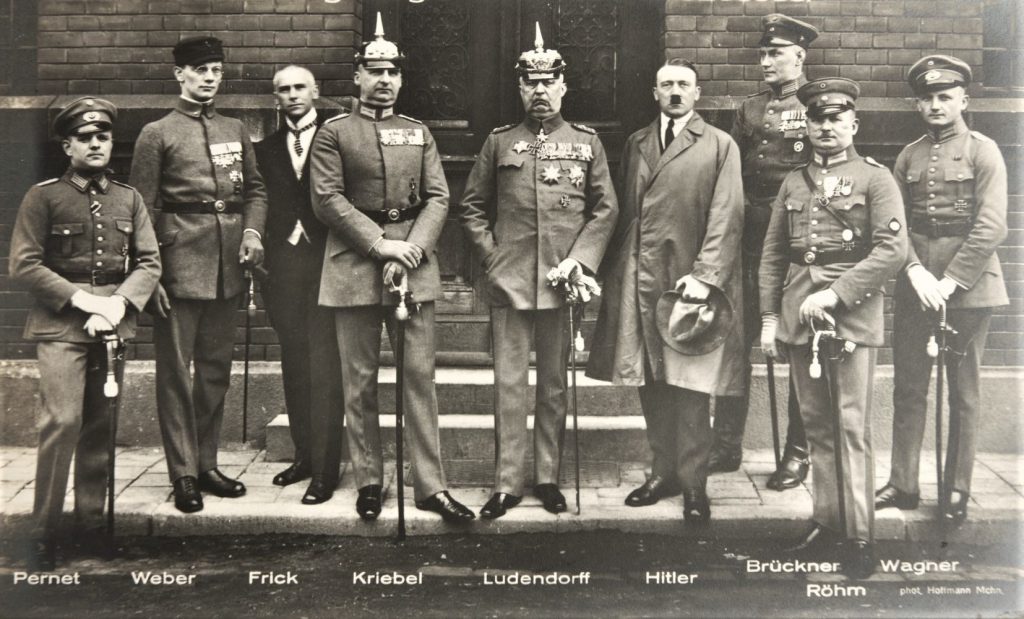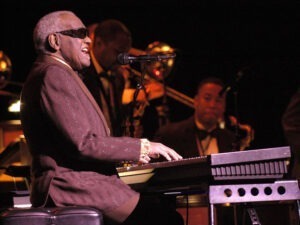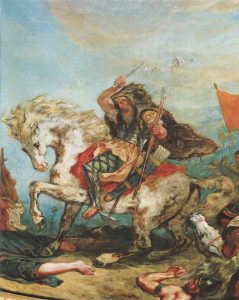On November 8, 1923, at around 8:30 pm, Adolf Hitler and his armed bodyguards of the SA surrounded the Bürgerbräukeller Beer Hall in Munich, Germany. Along with his bodyguards, when Hitler barged into the Beer Hall, he immediately fired his gun into the ceiling and shouted, “The National Revolution has begun. This building is occupied by six hundred heavily armed men. No one may leave the hall. Unless there is immediate quiet I shall have a machine gun posted in the gallery.”1 Hitler proclaimed that both the Bavarian and German Reich governments had been removed and there was now a provisional government being set up. Many of those present in the Beer Hall did not know what to believe. One thing that they were sure of was that the rifles and machine guns were real, so some followed Hitler’s orders. Though many were in amazement, there were some businessmen who were very upset, and one that even yelled for Hitler to shoot. However, others feared for their lives, afraid that a massacre was about to occur.2

The event underway has come to be called the Beer Hall Putsch. A Putsch is simply the German word for a military takeover of the government, or, in French, a coup d’etat.3 The idea for this Putsch came to Hitler from Benito Mussolini, who had staged a triumphant March on Rome in 1922, just the year before. Many of Mussolini’s followers were lower-middle-class Italians, and with their help, he threatened to take over the Italian government with his Fascist march on Rome. Like other Italian populist leaders before him, he put his reputation at risk in order to obtain power. If Mussolini’s march were to fail, he could lose his status in society, along with his respect.4 Mussolini’s first step was to create his own government. Without one, he would have no means to take over; so fascist militias and thugs began gathering from all over Italy.5 Once Mussolini gained power, he began to turn Italy into a Fascist state.6 Hitler imagined orchestrating a similar March on Rome that would start for Berlin from Munich’s famous Odeonsplatz the following morning, November 9, 1923. Odeonsplatz was just a few blocks away from the Bürgerbräukeller Beer Hall where Hitler and his assembled men had gathered that night.7

Through the Beer Hall, Hitler managed to push his way to the front of the hall where he took charge of the crowd. “He then ordered the Bavarian triumvirate—von Lossow, von Seisser, and von Kahr—into an adjoining room, where he bullied them at gunpoint into backing his putsch.”8 The three men were all government officials: Lossow was a general major, Kahr was the Minister President of Bavaria and Colonel, and Seisser was head of the Bavarian state police. Though they were already government officials, Hitler apologized to the men for the interruption on their speech and made a promise to them that they would have good jobs while he was in power. Hitler wanted the triumvirate on his side so that his Putsch would have the backing of actual government officials. However, when he tried to scare the three men into supporting the coup, it didn’t quite work, and they refused to talk or give any information that would give Hitler confidence that he had turned them. He then waved his pistol at them and shouted, “I have four shots in my pistol! Three for you, gentlemen. The last bullet for myself!”9 Though he really didn’t have their full support, Hitler believed he did. Once he thought he had the officials in control, Hitler would return to the crowd and give a speech. The audience went crazy over the speech. Their enthusiasm showed Hitler that he had already won them over. With Ludendorff being around as well, he had their support even more, because Ludendorff was respected and very well-known. Hitler’s first few steps had been made and the Putsch was, so far, going as planned, or so he thought.
So by this point, the Putsch had officially begun, and even though it had just begun, many problems were already occurring for Hitler. One way that Hitler planned for his Putsch to work was by seizing communication centers and state offices in Munich, and using the triumvirate to coordinate the military and police efforts to come. “While the rebels temporarily took over some offices, including the municipal headquarters of the Reichswehr and Munich police headquarters, they failed to secure other key centers.”10 The telegraph office was one key center they failed to seize, which allowed for news of the Putsch to get to Berlin and for orders to be received from General von Seeckt at Berlin military headquarters.11

The triumvirate, which were the three government officials, was left to Erich von Ludendorff to deal with. Ludendorff was currently Deputy Chief of Staff to the German Second Army under General Karl von Bülow. But more importantly, Ludendorff had been one of the most important generals for Germany during the first World War, and was hailed by many Germans as not only a war hero, but also as one of the most patriotic Germans of the day. Because Ludendorff was in such a high position in the army, Hitler wanted to use him as a figurehead in the march and even asked him to lead it. Ludendorff was also able to convince the triumvirate to follow Hitler’s orders, and in return, Hitler would give them the political roles that they wanted in the future government. Ludendorff then freed them, and once they were free, they immediately began planning to respond to the Putsch. Since Hitler and his followers had failed to seize all key centers, such as the ones in the city, the triumvirate was able to call suburban troops and police to Munich. Because these authorities knew what Hitler was doing, they planned well to meet him and his troops in the morning. In the time that they planned out what they would do, Hitler doubted for several hours whether he should continue the march to Berlin, because he found out about the betrayal of the triumvirate. Hitler delayed the start of the march for so long that the Bavarian authorities knew exactly what to do to defend Munich.12
“In a last ditch effort to rally citizens and soldiers, Hitler led around 2,000 Nazis and other Kampfbund members in a march to the Feldherrnhalle on the Ludwigsstrasse.”13 When the march reached Odeonsplatz, the marchers and Munich law enforcement met. There was a shootout where fourteen Nazis and four police were left dead at the scene; however, the march completely ended there and all the rebels fled from the scene. Later on, another two Nazis died, with the march being a complete failure.14
Eventually, Ludendorff was not charged at all, whereas Hitler was put on trial for treason and found guilty. “Hitler was sentenced to five years imprisonment in the old fortress of Landsberg and was eligible for parole after serving six months.”15 He was sent to jail on April 1, 1924, and was released a little less than nine months later, on December 20. Though many would think being imprisoned was terribly bad, Hitler, unlike many, received special treatments and in just the few months that he was incarcerated he was allowed frequent and constant visitations. During that time, he also wrote his manifesto, Mein Kampf.16 What did Hitler learn from this episode of the Beer Hall Putsch? He learned that if you want to take power in Germany, a Putsch is not the way. Beginning in his Landsberg prison cell Hitler began plotting his next move. He would come to power in Germany, not through an illegal Putsch, but through the legal means of the ballot box.
- William L. Shirer, The Rise and Fall of the Third Reich (New York: Simon and Schuster, 1960), 68. ↵
- William L. Shirer, The Rise and Fall of the Third Reich (New York: Simon and Schuster, 1960), 68. ↵
- ”Holocaust Encyclopedia (DC: Washington), s.v. “Beer Hall Putsch (Munich Putsch).” ↵
- Jennifer Stock, “Benito Mussolini Marches on Rome,” Global Events: Milestone Events Throughout History, Vol. 4: 339. ↵
- Jennifer Stock,”Global Events: Milestone Events Throughout History, Vol. 4, “Benito Mussolini Marches on Rome,” 2017: 339. ↵
- Gale Encyclopedia of American Law, 2010, s.v. “Benito Mussolini,” by Donna Batten. ↵
- Charles Keserich, “The Fiftieth Year of “March on Rome”: Recent Interpretation of Fascism,” The History Teacher, Vol. 6. No. 1 (Nov 1972): 135. ↵
- Holocaust Encyclopedia (DC: Washington), s.v. “Beer Hall Putsch (Munich Putsch).” ↵
- Ian Kershaw, Hitler: A biography (Wells Street, London: W.W. Norton Company, 2008), 128. ↵
- ”Holocaust Encyclopedia (DC: Washington), s.v. “Beer Hall Putsch (Munich Putsch).” ↵
- William L. Shirer, The Rise and Fall of the Third Reich (New York: Simon and Schuster, 1960), 71. ↵
- ”Holocaust Encyclopedia (DC: Washington), s.v., “Beer Hall Putsch (Munich Putsch).” ↵
- Holocaust Encyclopedia (DC: Washington), s.v. “Beer Hall Putsch (Munich Putsch).” ↵
- Holocaust Encyclopedia (DC: Washington), s.v., “Beer Hall Putsch (Munich Putsch).” ↵
- William L. Shirer, The Rise and Fall of the Third Reich (New York: Simon and Schuster, 1960), 78. ↵
- William L. Shirer, The Rise and Fall of the Third Reich (New York: Simon and Schuster, 1960), 78. ↵



54 comments
Eugenio Gonzalez
The article was informative, with a compelling narrative that maintains the reader’s attention with the developments of ”Beer Hall Pursch”. It was interesting to learn that Hitler was motivated by Mussolini’s military takeover. One would believe that Hitler would face a hostile situation in prison, but to my surprise, that would not be the case; it would be the opposite, where Hitler would benefit more as he would reflect and change his approach to obtaining power.
Adelina Wueste
This article provided a well written explanation of Hitlers first attempts to take over Germany. It interesting that Hitler took ideas from Benito Mussolini. I had assumed that in his first attempt, Hitler just jumped straight into doing what he thought would work. I didn’t realize that Hitlers initial efforts were a bit more calculated. I think it’s also interesting that Hitler continued his efforts despite being put in jail. I think that the German government assumed that by punishing Hitler, they would stop him, unfortunately the government’s efforts did not work.
Jaedon E
Amazing choice to write about. I knew a lot of interesting things about Hitler and the Nazi period. My 7th grade history teacher his family were refugees from fleeing from Germany from the Nazi’s. So reading this article, I learned some more interesting things about Hitler and his upbringing. One thing I didn’t know was that Hitler learned and gain his knowledge from reading books while serving his time, which was very astonishing to me. But overall great article!
Claire Saldana
This article painted the picture perfectly of what this time looked like for Germans. It was very scary but the people were also divided in how they felt about the government. It’s very interesting to see how he got to where he did. I think the government and law enforcement felt they were preventing him from growing in power by putting him in jail but it in fact is the reason he discovered the path to power and take over.
Gisselle Baltazar-Salinas
This article was really easy to read and concise I found it very informative on a topic I knew so little about but was always curious about. The author does a great job at tying it all together and how this event set the stage for the horrific events that are to follow Hitler’s planning. Who knows what would have happened if Hitler had had a different outcome following this event.
Kanum Parker
Time is one of the most important thing to a person, if they are giving all their time into studying on a subject it can lead to power in that area. Hitler sat down in jail and read many books gaining knowledge to be able to do what he did. If Hitler didn’t go to jail then maybe he wouldn’t have done what he had done in WW2.
Brittney Carden
Dayna did a great job with the introduction, I think she structured it in a way that really set the flow for the entire article. It was an easy read to both follow and understand. It was a very compelling narrative that kept me engaged the whole time. We have learned about Hitler our whole lives, but I found it very well-written, and refreshing.
Paulina Gonzalez
This article is very well detailed and has a lot of great information about Hitler’s first attempt to gain power. It’s interesting how high-ranking Munich officials like Ludendorff betrayed Hitler which caused him to get 5 years in prison for treason. It’s also interesting to see how Hitler benefited from this since he managed to gain popularity after and gain power. There is a lot of imagery that really helps the reader understand what is happening even though we already know what is going to happen. The article does a great job at setting up the future and how Hitler will rise to power and commit several awful atrocities.
Hali Garcia
This is a very well written article and it really kept me interested to the end. It was interesting to read about how Hitler tried to gain power in Germany and failed this time but later in the future, he will be successful. What struck me was how the triumvirate made Hitler think that they were on his side but once Ludendorff set them free they created a plan to stop Hitler.
Aaron Sandoval
This article was incredibly well detailed, while brief the author was able to include a lot of crucial details that really strengthened the article. While I have researched the rise of Hitler and his influence, this article was able to give me details that I had not heard of or covered. While I had heard of the Beer Hall Putsch and its failures, I had not known many of the details of its failures.